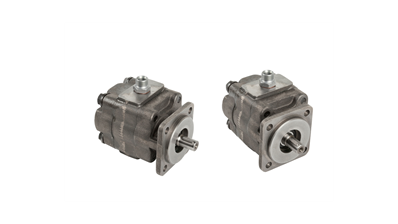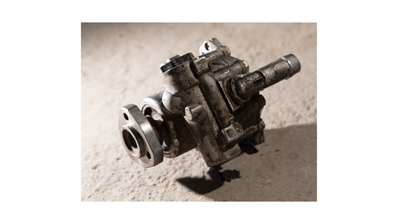Hydraulic Pump Basics: What You Should Know
.png?width=398&height=224) Whether you are a technician, construction worker, engineer, or mechanic who works with hydraulic pumps and related systems, there is basic info about hydraulic pumps you should know to ensure you are utilizing the system correctly and achieving proper performance.
Whether you are a technician, construction worker, engineer, or mechanic who works with hydraulic pumps and related systems, there is basic info about hydraulic pumps you should know to ensure you are utilizing the system correctly and achieving proper performance.
For starters, a hydraulic pump can fall into one of several basic categories—vane pumps, gear pumps and piston pumps.. There are a number of different variants of each of these and many other components to know about when planning, implementing, and maintaining hydraulic systems.
What Does a Hydraulic Pump Do?
A hydraulic pump performs two basic functions while a hydraulic system is in operation. The first task is to convert mechanical energy into fluid power by drawing oil from the reservoir and into the pump inlet.
The second function of the pump is to pump the fluid through the pump outlet and force it into the hydraulic system. Both of these functions are considered mechanical actions.
Does a Hydraulic Pump Create Pressure?
Some people mistakenly assume that hydraulic pumps create pressure to pump the hydraulic fluid through the system. However, this is not an accurate assumption. Rather, pumps create fluid flow, not pressure.
As the fluid flows through the system, there is resistance to the movement of the fluid. This resistance creates the pressure needed to overcome the resistance and allows the fluid to flow correctly.
What Are the Different Pump Classifications?
All hydraulic pumps fall into one of two classifications—non-positive-displacement pumps or positive-displacement pumps.
- Non-Positive Displacement Pumps – These pumps provide a steady fluid flow. They are well-suited for low-pressure systems. However, the flow rate output varies as system pressure changes.
- Positive-Displacement Pumps – A positive-displacement pump is commonly used in high-pressure hydraulic systems. Unlike non-positive-displacement pumps, there is no slippage. It is also possible to control the speed of the pump and adjust it as needed.
What Are Some Common Types of Pumps?

There are many different types of pumps, each with its own functions and applications. The more common ones include:
- Fixed-Displacement Pumps – A fixed-displacement pump is a type of positive-displacement pump where the flow rate remains constant and cannot be changed.
- Variable-Displacement Pumps – A variable displacement pump is another type of positive-displacement pump where you can adjust the flow rate to change the outlet pressure.
- Rotary Impeller Pumps – A rotary pump is also a positive-displacement pump. A rotating component uses energy from the motor to accelerate fluid away from the centre of rotation. For each rotation, the same amount of fluid that is drawn into the pump is moved out, regardless of the pressure.
- Axial and Radial Piston Pumps – Another type of positive-displacement pump, these use a cylinder-inside-a-cylinder design that enables hydraulic fluid to be moved via up and down motions and rotations. The pump design used the same concept as reciprocating pumps to generate the fluid flow. There are fixed and variable-displacement piston pumps.
- Plunger Pumps – Pistons reciprocate within fixed cylinders to move fluid into and out of the pump in this positive-displacement pump. There is also a positive seal between the inlet and outlet that supports higher pressures.
- Reciprocating Pumps – A reciprocating pump is another type of positive-displacement pump. As the piston extends, a partial vacuum is created, drawing fluid through the inlet. When it retracts, fluid is forced out of the pump. The same amount of fluid is drawn in as forced out of the pump.
- External Gear Pumps – Two identical gears rotate against one another inside a housing in this positive-displacement pump. One gear is turned by a drive shaft, which then turns the other gear. As the gears move, the fluid flows ar,ound the outside of each gear the two flows meeting at the point on the opposite side, of where the gears mesh, from the point where the fluid was picked up by the gear teeth.
- Internal Gear Pumps – Inside this positive-displacement pump housing, two internal gears of different sizes rotate inside one another. The inner gear has one or two fewer teeth than the outer one. This allows a low relative speed, a smoother oil flow and quieter performance to most external gear pumps.
- Screw Pumps – Screw pumps use one, two, or three helical screw shafts inside the pump housing to guide fluid in a linear direction. This type of positive-displacement pump is typically larger and used for large-volume and lower pressure applications.
- Lobe Pumps – A lobe pump is a type of positive-displacement rotary, external gear pump..
- Vane Pumps – Another type of positive-displacement rotary pump, a vane pump uses vanes to direct the fluid through the pump housing while maintaining a tight seal on the inside of the cam ring within which the vanes run.
- Centrifugal Pumps – A centrifugal pump is a non-positive-displacement pump. It moves fluid through the pump using impellers. As the fluid enters the pump, the rotation of the impellers creates a centrifugal force to force fluid out of the pump. These are very rarely used in fluid power applications but are used a lot when pumping water for irrigation etc.
- Trochoidal pump is a type of internal gear pump that is like a cross between a rotary lobe and an internal gear pump, used in low pressure applications such as providing charge flows to closed loop piston pumps.
Common Hydraulic Pump Components
The components found in a hydraulic pump can and do vary depending on the pump being used in the hydraulic system. However, all hydraulic pumps share some common components, such as:
- Pump Housing – All pumps have an exterior housing to protect the internal components.
- Pump Shaft – A pump will have at least one shaft to rotate and turn the impeller inside the pump.
- Seals – Seals are used to prevent fluid leaks and can be found at various locations within the pump.
Other components found on hydraulic pumps can consist of the following, depending on the type of pump:
- Check Valve
- Gears
- Load Sense Controls
- Pistons
- Rotors
- Torque Limiter Controls
- Compensators
- Electronic Displacement Controls
- Springs
- Pressure Valves
- Pressure Compensators
What Type of Pump Is Best?

Deciding what type of pump is best for your applications depends on several factors, including:
- The design of the system
- The desired fluid flow rate
- High-pressure or low-pressure applications
- The type of hydraulic fluid used in the system
- The maximum operating pressure
- The amount of pump maintenance required
- Pump replacement costs
- Whether you require a variable displacement.
As you can see, choosing the best pump requires a lot of knowledge about your hydraulic system and the different types of pumps. Therefore, before working with or using a hydraulic system, always verify what pump is used. Also, take the time to familiarise yourself with the controls, parts, and components.
Whether you know what type of pump you need or require assistance in choosing the best one, the hydraulic system experts at White House Products, Ltd. are here to help.
For further information and assistance selecting the best hydraulic pump to fit your needs, please feel free to contact us at +44 (0) 1475 742500 today! We can also custom-build hydraulic pumps to your exact specifications.
Back to blog posts